CMMI®开发模型,版本 1.3
CMMI-DEV,1.3 版
CMMI 产品团队
为开发更好的产品与服务而改进过程
2010 年 11 月
技术报告
CMU/SEI-2010-TR-033
ESC-TR-2010-033
软件工程过程管理项目
有版权约束的无限制分发
http://www.sei.cmu.edu
�
This report was prepared for the
SEI Administrative Agent
ESC/XPK
5 Eglin Street
Hanscom AFB, MA 01731-2100
The ideas and findings in this report should not be construed as an official DoD
position. It is published in the interest of scientific and technical information
exchange.
This work is sponsored by the U.S. Department of Defense. The Software
Engineering Institute is a federally funded research and development center
sponsored by the U.S. Department of Defense.
Copyright 2010 Carnegie Mellon University.
NO WARRANTY
THIS CARNEGIE MELLON UNIVERSITY AND SOFTWARE ENGINEERING
INSTITUTE MATERIAL IS FURNISHED ON AN “AS-IS” BASIS. CARNEGIE
MELLON UNIVERSITY MAKES NO WARRANTIES OF ANY KIND, EITHER
EXPRESSED OR IMPLIED, AS TO ANY MATTER INCLUDING, BUT NOT
LIMITED TO, WARRANTY OF FITNESS FOR PURPOSE OR
MERCHANTABILITY, EXCLUSIVITY, OR RESULTS OBTAINED FROM USE
OF THE MATERIAL. CARNEGIE MELLON UNIVERSITY DOES NOT MAKE
ANY WARRANTY OF ANY KIND WITH RESPECT TO FREEDOM FROM
PATENT, TRADEMARK, OR COPYRIGHT INFRINGEMENT.
Use of any trademarks in this report is not intended in any way to infringe on the
rights of the trademark holder.
Internal use. Permission to reproduce this document and to prepare derivative
works from this document for internal use is granted, provided the copyright and
“No Warranty” statements are included with all reproductions and derivative
works.
External use. This document may be reproduced in its entirety, without modification, and freely distributed in
written or electronic form without requesting formal permission. Permission is required for any other external
and/or commercial use. Requests for permission should be directed to the Software Engineering Institute at
permission@sei.cmu.edu.
This work was created in the performance of Federal Government Contract Number
FA8721-05-C-0003 with Carnegie Mellon University for the operation of the
Software Engineering Institute, a federally funded research and development
center. The Government of the United States has a royalty-free
government-purpose license to use, duplicate, or disclose the work, in whole or in
part and in any manner, and to have or permit others to do so, for government
purposes pursuant to the copyright license under the clause at 252.227-7013.
For information about SEI publications, please visit the library on the SEI website
(www.sei.cmu.edu/library).
The following service marks and registered marks are used in this document:
Capability Maturity Model
�
Carnegie Mellon CERT CMM CMMI CMM Integration IDEALSM
SCAMPISM
CMMI, CMM, CERT, CMM Integration, Carnegie Mellon, and Capability
Maturity Model are registered in the U.S. Patent and Trademark Office.
SCAMPI and IDEAL are service marks of Carnegie Mellon University.
�
本报告为以下机构编写:
SEI Administrative Agent
ESC/XPK
5 Eglin Street
Hanscom AFB, MA 01731-2100
本报告中的观点与发现不应被视为美国国防部的正式立场。其出版是为了科
学与技术的信息交流。
此项工作由美国国防部发起并资助。软件工程研究所是由美国国防部发起并
资助、由联邦政府供资金的研究与开发中心。
版权所有:卡内基梅隆大学,2010 年
无担保
卡内基梅隆大学与软件工程研究所拥有的本资料“按现状”供。卡内基梅
隆大学对任何明示或暗示的事项不做任何担保,其中包括但不限于其适用性、
适销性、排他性或使用本资料所产生的结果。卡内基梅隆大学对于专利、商
标或著作权方面的侵权责任免除不做任何担保。
本报告中任何商标的使用都没有以任何方式侵害商标所有人权利的意图。
内部使用。只要版权与“无担保”声明包含在所有的复制文档以及衍生著作
内,允许复制本文档或编写本文档的衍生著作供内部使用。
外部使用。无需申请正式的许可,允许对本文档进行无任何修改的完全复制,并以书面或电
子形式进行免费分发。其它任何外部的并且/或者是商业的用途则需要请求许可。许可请求
应发送至软件工程研究所的 permission@sei.cmu.edu。
本著作于履行联邦政府与卡内基梅隆大学订立的、与运作联邦政府资助的研
究与开发中心软件工程研究所有关的联邦政府合同(编号 FA8721-05-C-0003)
期间所创建。美国政府拥有免版税政府用途许可,能够以全部或部分或任何
方式使用、复制或公布此项工作。政府根据版权许可条款 252.227-7013,允
许他人出于政府目的进行同样操作。
欲 了 解 有 关 SEI 出 版 物 的 信 息 , 请 访 问 SEI 网 站 中 的 书 库
(www.sei.cmu.edu/library)。
本文档使用以下服务标记与注册标记:Capability Maturity Model
Carnegie Mellon CERT CMM CMMI CMM Integration IDEALSM
SCAMPISM
CMMI,CMM,CERT,CMM Integration,Carnegie Mellon 及 Capability Maturity
Model 已注册于美国专利与商标局。
SCAMPI 与 IDEAL 是卡内基梅隆大学的服务标记。
�
简体中文版序(原文)
Over the last couple decades, China has emerged as a world-class economic
power. People around the world often find themselves surrounded by products
“made in China.” Most are labor-intensive products such as toys and textile
goods, but, increasingly, many are higher quality products that require
significant, large-scale engineering work. Success in such more complicated
endeavors requires disciplined and mature development processes. Using the
Capability Maturity Model Integration (CMMI) as a guide for process
improvement has been important to many companies’ journeys to more robust
and predictable processes that help achieve business success.
It is no exaggeration that China has become one of the most active adopters of
CMMI. Data from the Software Engineering Institute shows that China has
reported more CMMI appraisals than any other country—including the United
States—for several years in a row. China has impressed the world not only by its
unprecedented economic growth, but also by its passion in pursuing best
practices, such as those found in CMMI.
I am very pleased that the Simplified Chinese version of CMMI for
Development (CMMI-DEV) is now available. This will certainly give the
CMMI community in China a better tool to overcome the language barrier to
understanding the true essence of CMMI. With this translation, we expect to see
even more success stories of Chinese organizations achieving world-class
performance as reflected in both product and performance measures.
I would like to extend my appreciation to all the participants of this translation
project, especially to their leader Mr. Yue Zhao, who is a vigorous CMMI
advocate and seasoned CMMI practitioner. The translation was by no means a
straightforward endeavor. In addition to the significant amount of time devoted
to the task, the project pursued several approaches to ensure translation quality,
including establishing an independent verification team, setting a 100% internal
review requirement, adopting an incremental and iterative translation process,
and creating a keyword database and automatic matching system. We have
confidence that the whole CMMI community in China and elsewhere will
benefit from their dedication to translate CMMI accurately in both letter and
spirit.
Paul D. Nielsen
Director and Chief Executive Officer
Software Engineering Institute
Carnegie Mellon University
December 26, 2012
�
简体中文版序(译文)
经过几十年,中国已然成为一支世界级的经济力量。世界各地的人们时常
发现自己置身于“中国制造”产品的包围之中,其中多为玩具、纺织品等
劳动密集型产品。然而渐渐地,需要大量规模化工程工作的、更具品质的
产品亦已为数不少。要成功从事这样更为复杂的工作,就需具备规范成熟
的开发过程。对很多公司来说,在使他们的过程更扎实、更可预测,以助
力其业务成功的旅程中,使用能力成熟度模型集成(CMMI)作为改进指
南具有重要意义。
毫不夸张地说,中国已成为 CMMI 的最活跃采用方之一。软件工程研究所
的数据显示,中国所呈报的 CMMI 评估总数已经连续数年超过了包含美国
在内的其它任何国家。中国令世界所瞩目的,不仅是其前所未有的经济增
长,还有其追求最佳实践的热情,比如那些存在于 CMMI 之中的最佳实践。
如今有了 CMMI 开发模型(CMMI-DEV)简体中文版,我为此感到十分欣
慰。毫无疑问,这将供给中国的 CMMI 群体一种更好的工具,去克服语
言障碍,从而理解 CMMI 的真谛。我们由此可以期盼更多中国组织的成功
案例,他们能够达成世界级的绩效水准,并以产品度量和绩效度量进行展
现。
我衷心地感谢参加此次翻译项目的所有成员,尤其是带领团队的赵悦先生,
他既是一位充满活力的 CMMI 倡导者,也是一位身经百战的 CMMI 实践者。
翻译工作绝非易事。该项目除了投入大量的时间,还采取了多种方法来确
保翻译质量,包括建立了独立的验证团队,设定了百分之百的内部审查要
求,采用了增量式与迭代式并用的翻译过程,同时创建了关键字数据库和
自动匹配系统。我们坚信,中国乃至其它地方的整个 CMMI 群体都将受益
于他们为形神兼备地精准翻译 CMMI 而作出的尽心奉献。
卡内基梅隆大学软件工程研究所
所长兼首席执行官
保罗 D 尼尔森
2012 年 12 月 26 日
�
译者序
CMMI 开发模型(CMMI-DEV)简体中文版在我们翻译小组与验证小组的
携手努力下,历经几次反复终得以完成。早在 2007 年,我们便通过美国
卡内基梅隆大学软件研究院,取得了软件工程研究所的翻译授权。那时,
CMMI 在中国正遍地开花,以 CMMI 为主题的 SEPG 中国大会也进行得风
生水起。我们难免羁绊于各种大小事务,不知不觉耽误了翻译工作的进程。
直至今年年初,我们再一次全力以赴,以一年的辛苦劳作,CMMI 官方中
译本终于完稿。对此我们如释重负,因为我们深知业界对 CMMI 中译本已
经期盼多年,我们贸然开始的这项艰巨工作最终没有再次让大家失望。
经过十几年的历程,CMMI 在中国业已枝繁叶茂,CMMI 年评估数量已经
连续数年处于全球第一。固然这只是中国经济高速发展的一个缩影,但无
可否认,CMMI 模型在中国成为软件与系统工程行业过程改进最主流标准
的既成事实,亦源于 CMMI 体系自身的价值。唯因其结构之严谨、内容之
完整、阐述之具体、方法之系统,方奠定其在产业界的举足轻重地位。将
CMMI 博大精深之旨,以另一种迥异的语言精确而流畅地进行表达,是我
们的一项极富挑战性的工作。
为此,我们的翻译工作不可谓不小心翼翼。除设立独立验证组进行客观审
查之外,模型的每一行翻译都首先经过翻译组的内部评审。在翻译组解决
了内部评审的数千条问题点的基础上,独立验证组仍然出数以千计的问
题点,我们再不惮其烦逐个解决。我们的期许在于,以这样事无巨细、悉
究本末的态度,去追求一次经典的翻译过程。事实上,无论是翻译组还是
验证组,所有成员均为 CMMI 业界之历练之士。执著于这样严格的翻译流
程,或许是我们内心深处对 CMMI 的痴迷所使然,而这样的痴迷不免渗透
至译文的字里行间,假如读者在阅读中能够感知一二,并因此受益,即可
给我们以极大宽慰。
当然绝非老套之语,或因才疏学浅,或因时间仓促,翻译中难免有所疏漏,
恳请读者指正,并予以见谅。
卡内基梅隆大学软件研究院
CMMI 模型翻译组组长
赵悦
2012 年 12 月 11 日
�
CMMI-DEV 1.3 版简体中文翻译参加人员
以下人士参加了 CMMI-DEV 1.3 版的简体中文翻译工作。成员姓名在各小
组中以姓名的汉语拼音字母顺序排列,姓名后列出的是翻译完稿时该成员
所代表的组织。
• 陈豪,苏州华隆信息科技有限公司
• 华国红,中兴通讯股份有限公司
• 王岩,中国惠普有限公司
• 吴超英,北京航空航天大学
• 吴言,苏州华隆信息科技有限公司
• 徐明庆,北京赛科技有限责任公司
• 许娓,北京赛科技有限责任公司
• 袁庆平,北京高迈致远信息技术有限公司
• 赵悦,卡内基梅隆大学软件研究院(组长)
• 李巍,循序咨询(上海)有限公司(组长)
• 任仲泉,循序咨询(上海)有限公司
• 张圣洁,循序咨询(上海)有限公司
• 居德华,华东理工大学
• 宋骏,普华永道信息技术(上海)有限公司
• 王青,中国科学院软件研究所
• 张凯,循序咨询(上海)有限公司
• Mike Konrad,Software Engineering Institute(翻译组支持)
• Malcom Patrick,循序咨询(上海)有限公司(验证组支持)
翻译组成员
验证组核心成员
验证组外围成员
翻译工作支持人员
�
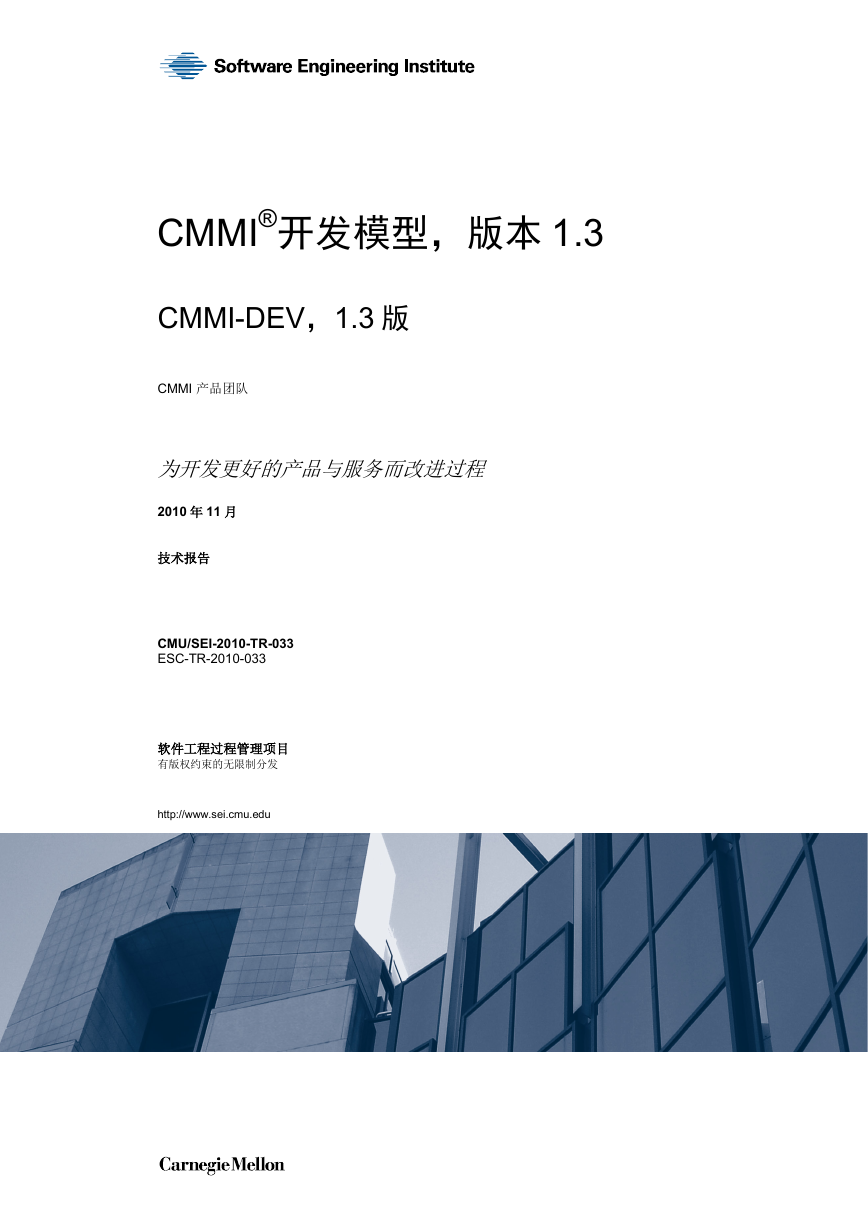
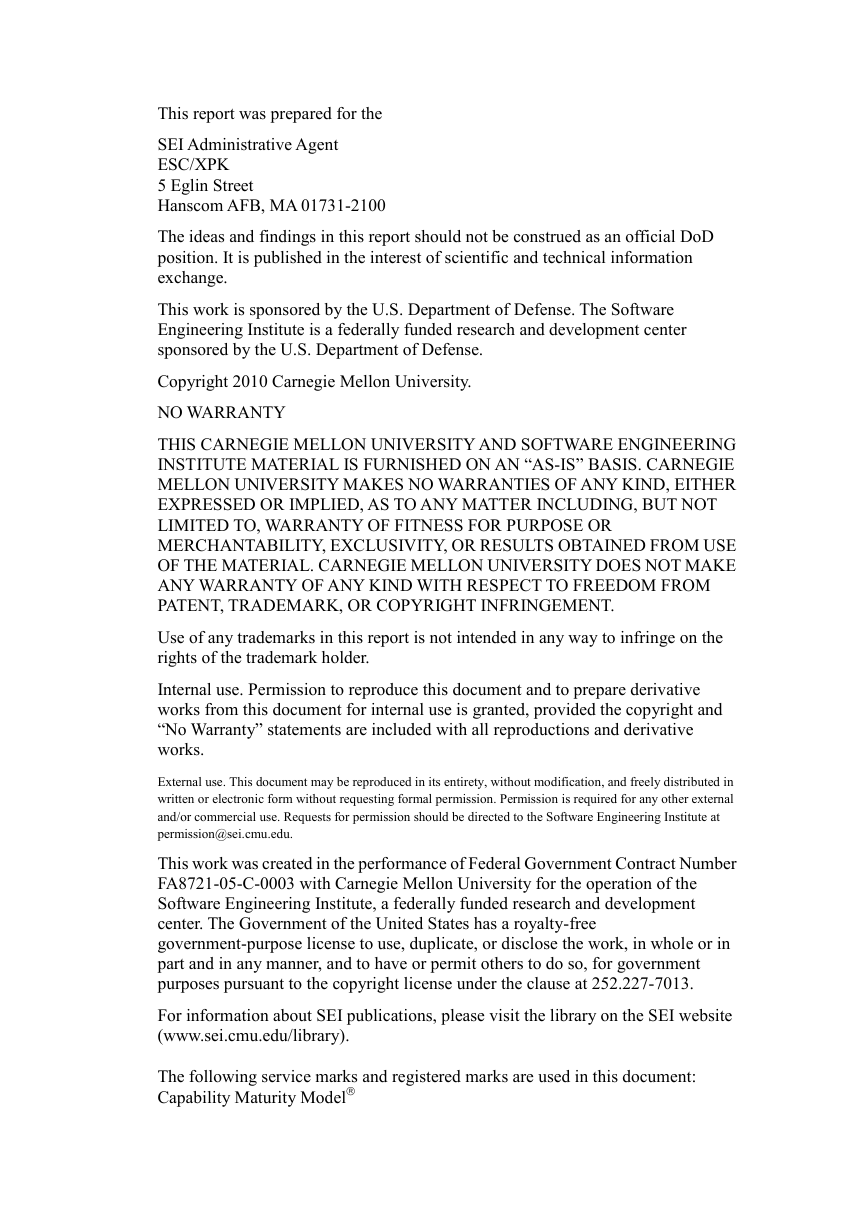
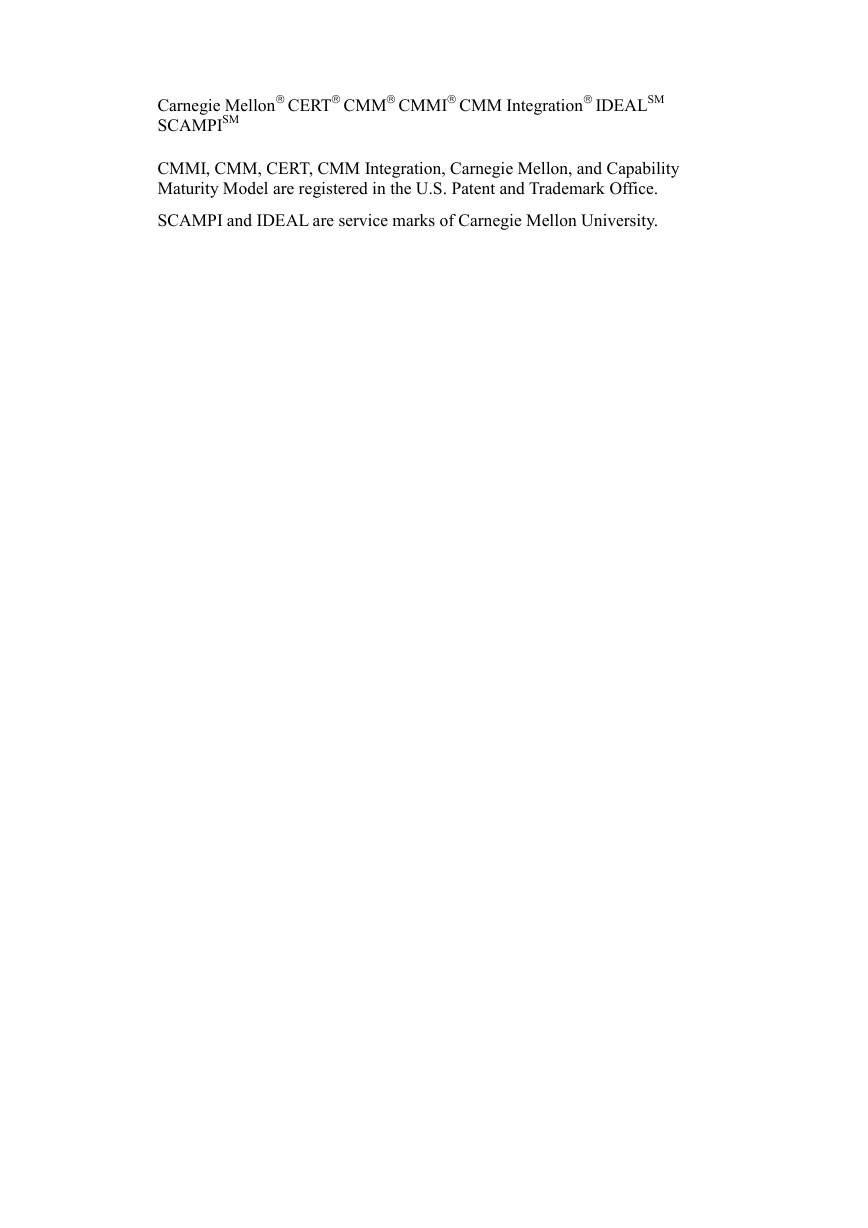
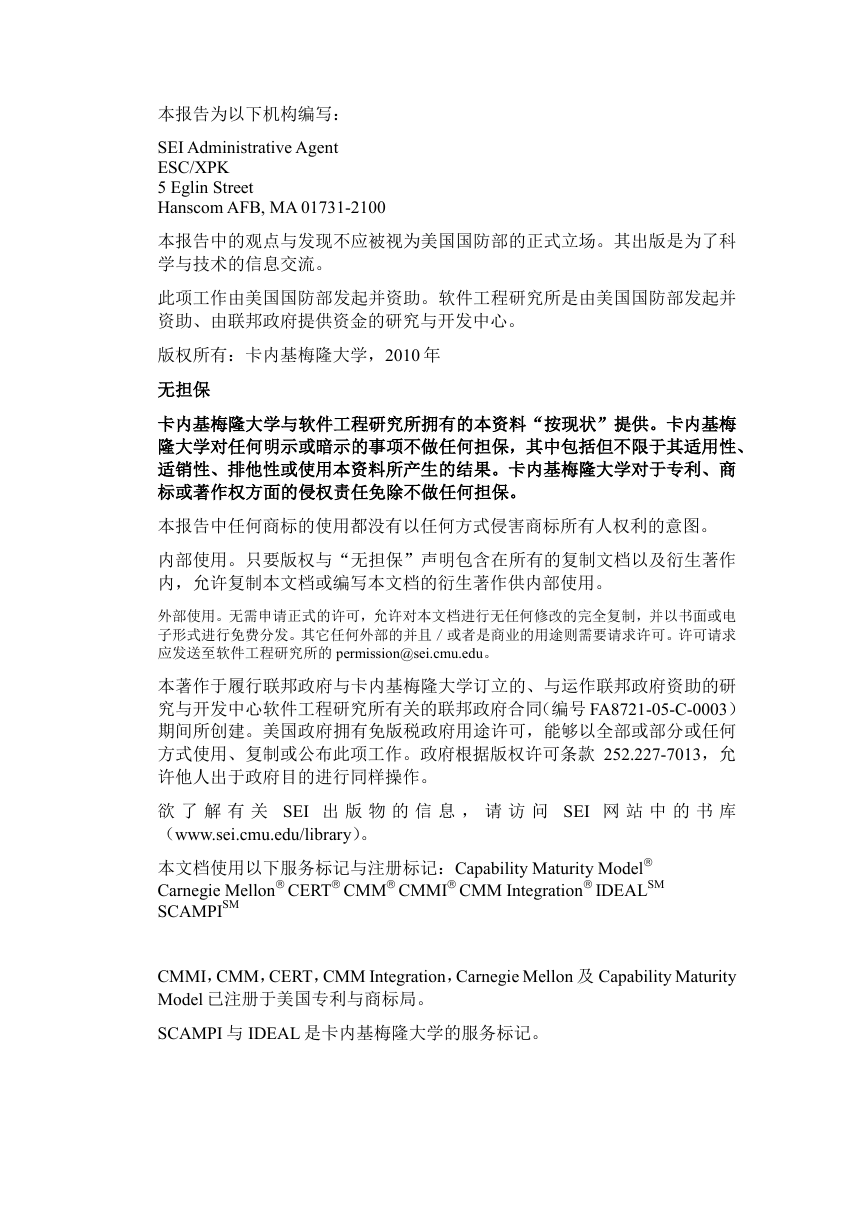
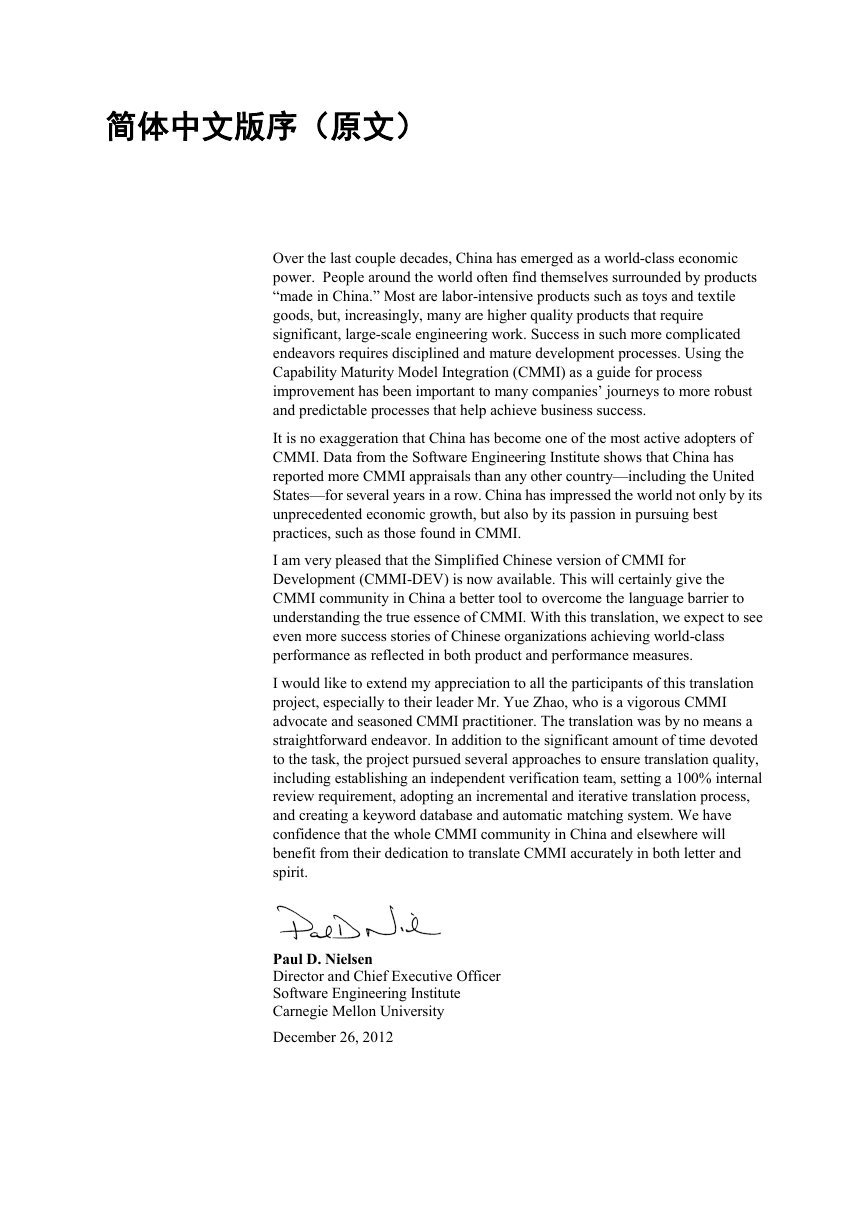
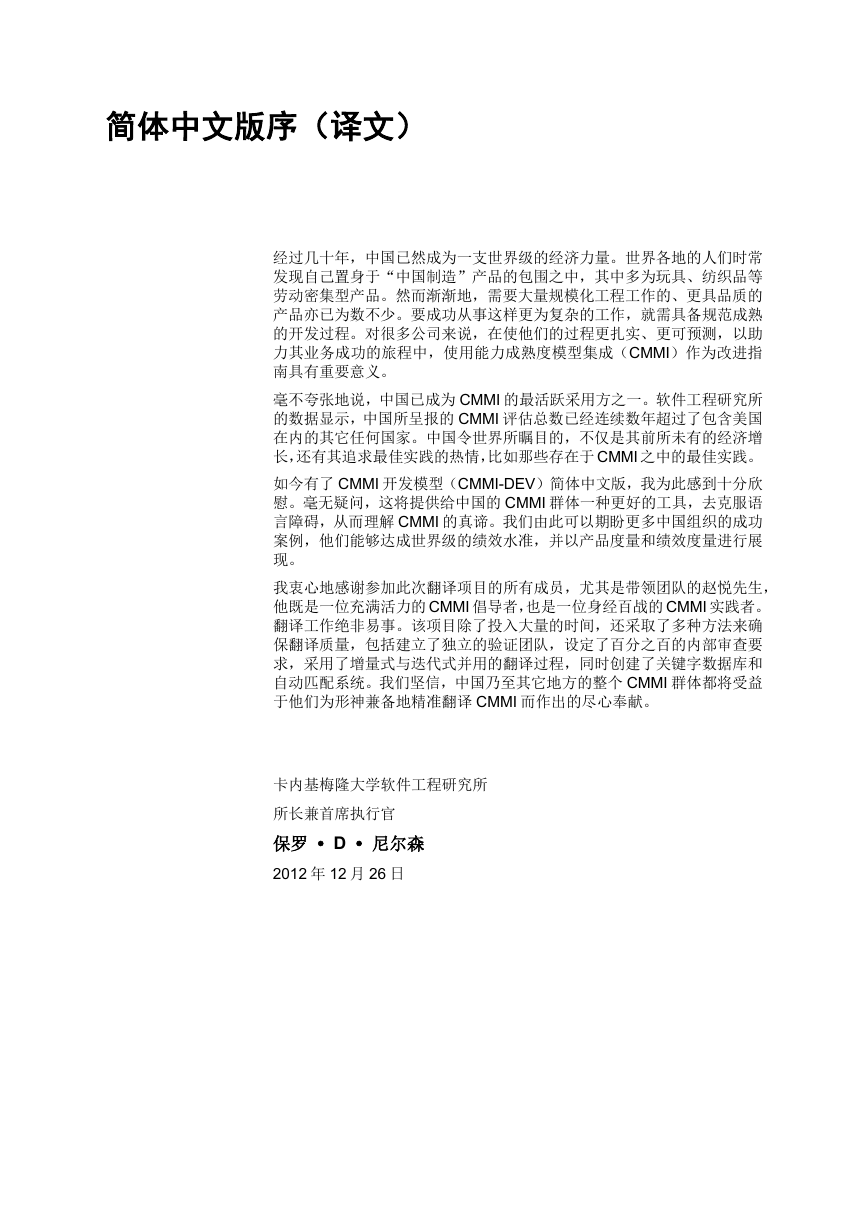
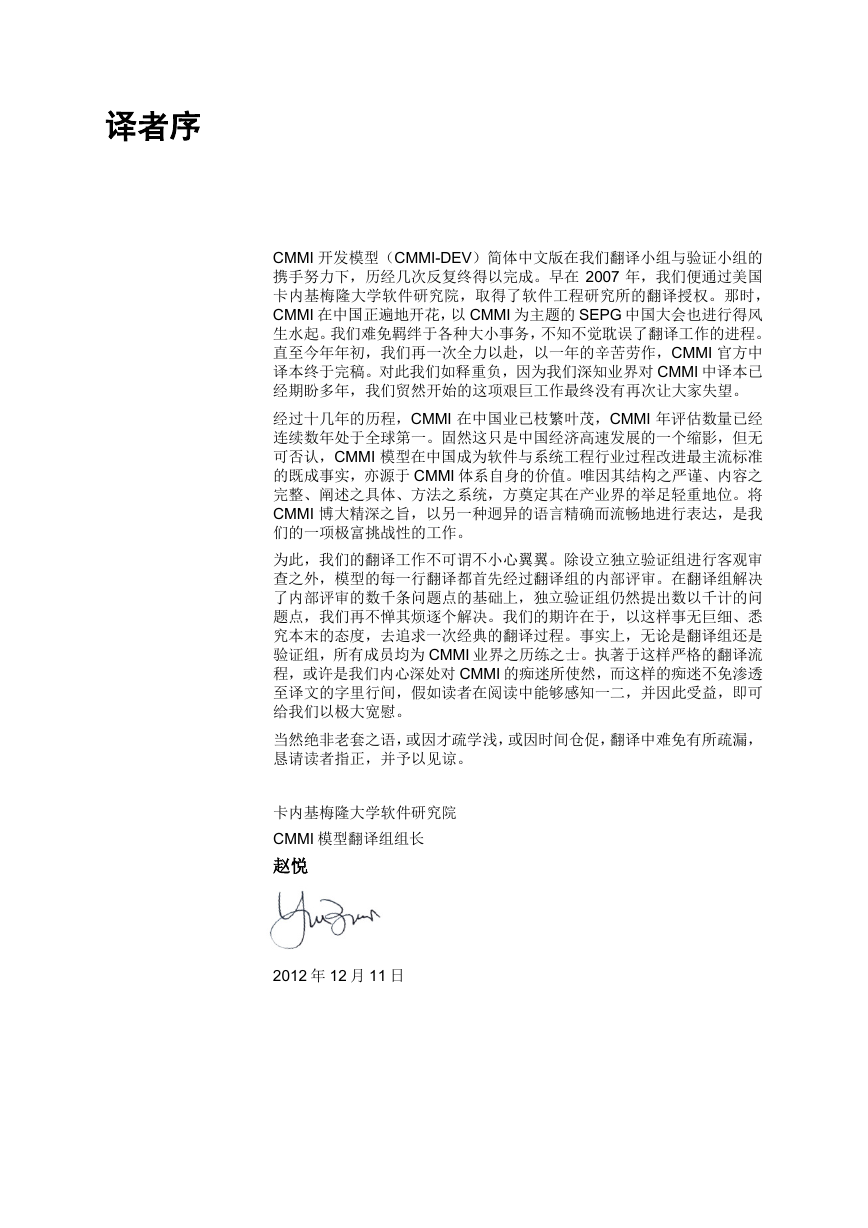









 2023年江西萍乡中考道德与法治真题及答案.doc
2023年江西萍乡中考道德与法治真题及答案.doc 2012年重庆南川中考生物真题及答案.doc
2012年重庆南川中考生物真题及答案.doc 2013年江西师范大学地理学综合及文艺理论基础考研真题.doc
2013年江西师范大学地理学综合及文艺理论基础考研真题.doc 2020年四川甘孜小升初语文真题及答案I卷.doc
2020年四川甘孜小升初语文真题及答案I卷.doc 2020年注册岩土工程师专业基础考试真题及答案.doc
2020年注册岩土工程师专业基础考试真题及答案.doc 2023-2024学年福建省厦门市九年级上学期数学月考试题及答案.doc
2023-2024学年福建省厦门市九年级上学期数学月考试题及答案.doc 2021-2022学年辽宁省沈阳市大东区九年级上学期语文期末试题及答案.doc
2021-2022学年辽宁省沈阳市大东区九年级上学期语文期末试题及答案.doc 2022-2023学年北京东城区初三第一学期物理期末试卷及答案.doc
2022-2023学年北京东城区初三第一学期物理期末试卷及答案.doc 2018上半年江西教师资格初中地理学科知识与教学能力真题及答案.doc
2018上半年江西教师资格初中地理学科知识与教学能力真题及答案.doc 2012年河北国家公务员申论考试真题及答案-省级.doc
2012年河北国家公务员申论考试真题及答案-省级.doc 2020-2021学年江苏省扬州市江都区邵樊片九年级上学期数学第一次质量检测试题及答案.doc
2020-2021学年江苏省扬州市江都区邵樊片九年级上学期数学第一次质量检测试题及答案.doc 2022下半年黑龙江教师资格证中学综合素质真题及答案.doc
2022下半年黑龙江教师资格证中学综合素质真题及答案.doc